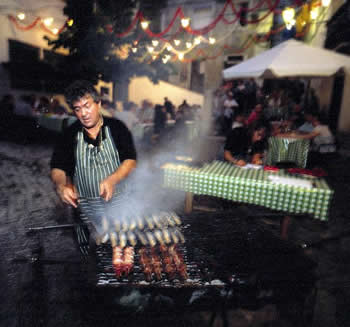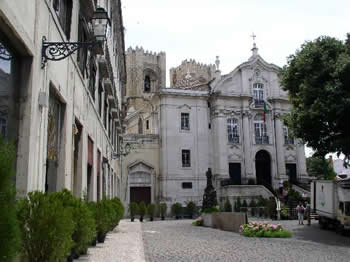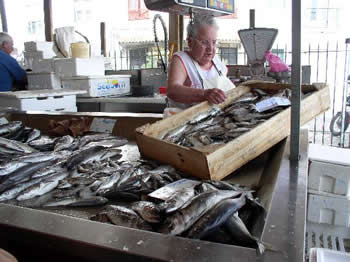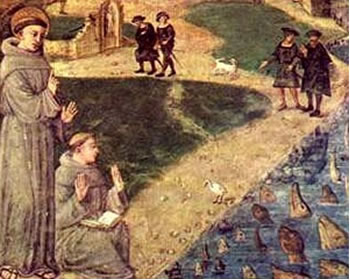 |
|
|
|
|
|
|
|
|
|
|
|
|
|
|
|
|
|
|
|
|
|
|
 |
 |
|
|
|
|
|
|
|
|
|
|
|
|

|
The Feast of St. Anthony Sardine Heaven
Looking out the window of a music store in Lisbon, Portugal, I laughed out loud watching a passing parade of vintage convertible cars progressing along Avenue Liberdade. They were filled with brides of all sizes, shapes, and ages, and dressed in wedding finery. The owner of the shop said that the young women were "brides of St. Anthony," and the procession was a traditional part of the saint's feast day. He added that marital couples who are poor are hosted by city hall without cost to them. I was in Lisbon to celebrate the Feast of St. Anthony and had begun the day by attending Mass at the saint's church. I made my way slowly through the crowd to the front altar and found a golden and crystal reliquary on display. At closer examination I noted that some sort of bone was inside. I later found out that it was part of St. Anthony's right forearm. In the front lobby of the church was a small gift shop. A group of women selling little bread rolls about the size of golf balls caught my eye. People were pushing and shoving to make their purchases. As I watched I noted that many of the women went back into the church and pressed the bread against a glass-covered portrait of the saint. Then I noticed that several women were scribbling little messages on slips of paper, folding them up and sticking them into the frame around the portrait. I followed the custom and wrote down a special prayer, dutifully folded the note, and tucked it into the frame along with my bread roll. The tradition of "St. Anthony's Bread" goes back to 1263 when a child drowned in the Brenta River near the Basilica of St. Anthony in Padua, Italy. The mother went to St. Anthony and promised that if her child were restored to life, she would give to the poor an amount of wheat equal to the weight of her child. Her son was saved and she kept her vow. Thereafter, "St. Anthony's Bread," became the promise of giving alms in return for a favor asked of God through the saint's intercession. Learning about and taking part in these wonderful customs was enjoyable and I left the church with an urge to see what else I could discover about St. Anthony.
Fado, the emotion-laden, dramatic music particular to Portugal came long after Anthony. Audiences listening to fado are likely to find an image of Anthony behind the singer (fadista) and instrumentalists. A major theme of this kind of music is nostalgia and a longing for what is lost and for what can never be regained. Anthony fits into this scene. The man who became known to many as Anthony of Padua was actually Portuguese. Although many Portuguese were seamen, Anthony left his homeland on a different type of voyage, that of a spiritual seaman. He became a fearless missionary traveling first to Morocco and then through southern France and northern Italy on foot. While in Rimini on Italy's Adriatic coast he encountered some difficulty in getting the local populace to listen to him. Somewhat dejected, he went down to the shore where the Ariminus River runs into the sea, and began to speak to the fishes. No sooner had he spoken a few words when suddenly a great a multitude of fish, both small and large, approached the bank on which he stood. All the fish had their heads out of the water and seemed to be looking attentively at St Anthony's face; all were peacefully lined up in perfect order--the smaller ones in front near the bank, medium-sized next, and lastly where the water was deepest, the largest ones. As he continued speaking, the fish began to open their mouths and bow their heads, endeavoring as much as was in their power to express their reverence. The people of the city, hearing of the miracle, hurried to witness it.
I had heard that those miraculous fish were sardines and were an important part of the festivities and so I thought I'd eat some for lunch. I went into a pleasant restaurant almost salivating as I thought of the tasty fish. Alas, the maitre'd almost sneered as he said they did not have sardines there. I tried several other restaurants to no avail. It wasn't until the at the music store owner directed me down a narrow street lined with small restaurants and outdoor tables that I found sardines. They were proudly displayed in all their silvery glory in a refrigerated case. Needless to say, my lunch was totally divine! It turns out that the opening of sardine season coincides with the Feast of St. Anthony and all over the city people grill them on every type of grill. The expensive restaurants can't compete and natives won't pay their prices for this local specialty. The fame of St Anthony's wonders has never diminished, and even at present, he is acknowledged as the greatest miracle worker of the times. He is especially invoked for the recovery of things lost and against starvation and infertility. He is patron of amputees, boatmen, Brazil, diocese of Beaumont, domestic animals, the elderly, expectant mothers, faith in the Blessed Sacrament, the small Italian town of Ferrazzano, fishermen, harvests, horses, Lisbon, mail, mariners, oppressed people, Padua, paupers, Portugal, sailors, swineherds, Tigua Indians, travel hostesses, and travelers. St Anthony is known as the matchmaker saint and on the eve of his day, June 13th, girls try various methods of finding out whom they will wed. One favorite way is for a girl to fill her mouth with water and hold it until she hears a boy's name mentioned. The name she hears is sure to be that of her future husband! Another way to recognize "the gentleman" is to make an agreement with St. Anthony by a sign or an object that only the girl and the saint of know about. A popular ritual advises:
The next day, look at the pap-ers. The name that has unrolled the most is your perfect partner! Single women have been known to buy a small statue of Saint Anthony and place or bury it upside down for a week as blackmail, and righting it after they find a good husband. A charming custom of the day is for young men to present a pot of basil to the girls they hope to wed. Within the petals is a verse or message that indicates the young man's passion. Pots of basil are displayed on almost every balcony around the city and are often given as gifts with little verses invoking St. Anthony or of love and affection for the recipient. I discovered that the entire city celebrates St. Anthony the night of June 12 to 13th. Altars are built, parades are held, and streets are decorated. The air is filled with the delicious smell of sardines being grilled at bonfires lining almost every thoroughfare, especially in the Alfama district of the city. The biggest parade is the Marchas Populares, along the Avenue Liberdade. Along with a few friends I found an ideal viewing spot not far from my hotel. We watched as countless marchers passed by. Every neighborhood in Lisbon has its own contingent with colorful costumes, floats, and marching bands. There is a prize for the best group. As the parade continued past midnight, my friends and I became hungry and headed over to the Alfama district for grilled sardines. We had been invited to a small neighborhood bar with a patio behind it. There we were treated to beautifully grilled sardines, served on a slice of bread on napkins and paper plates. We drank sangria from plastic cups and licked our fingers as we reached for another fish. The pile of bones stacked up in the middle of our table and still the fish kept coming. I was in sardine heaven! Of all the beautifully prepared meals I had while in Portugal, this midnight snack remains a highlight. Jacqueline Harmon Butler Fall 2006 |
||||||||||



